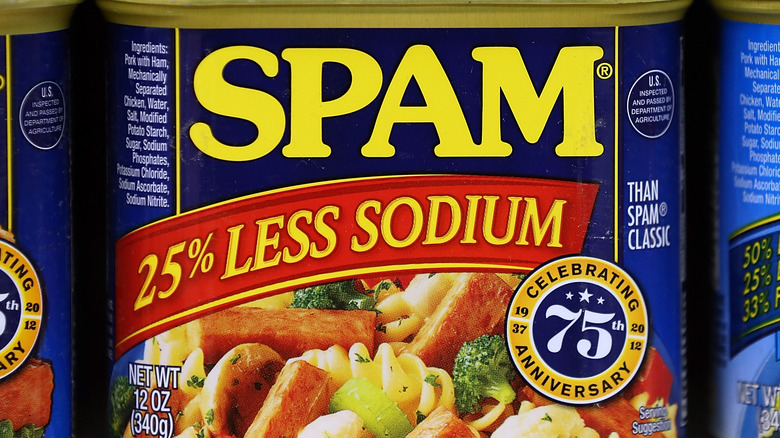What Does The Name SPAM Really Stand For?
Although canned food specialist Hormel originally invented SPAM in 1937, the product that requires no refrigeration and is good for years came to prominence during WWII, when the pork and potato starch-based luncheon meat proved to be excellent fare for troops fighting overseas. An estimated 100 million pounds of it were sent to military personnel, aiding the war effort immeasurably, even if reviews from the troops were not always positive. (Company president Jay Hormel actually created a file for all the complaints he received.)
However, many found the product attractive, and not just in Hawaii, where SPAM became an integral part of local cuisine in the postwar years. Hormel managed to sell one billion cans of SPAM by 1959, and to date, some eight billion have been purchased. It's a rather astounding number considering SPAM is reportedly made from pork shoulder, one of the least desirable cuts, as well as ingredients as unsexy as sodium nitrate.
The most fascinating thing about SPAM isn't its ingredient list, however, but its strange name and the story behind its creation. No, it wasn't labeled spam by Hormel executives. Strangely enough, it was invented by an obscure actor, who reportedly came up with the term well before he ever tasted the actual product.
The strange story behind SPAM's name
According to the SPAM Museum, the name SPAM was originally a shortened version of "spiced ham." But Ken Daigneau, the man credited with inventing the name, came up with it independent of the actual product. An actor by trade, Daigneau said he just liked how the name sounded, and as fate would have it, he had a brother who worked as an executive for Hormel. Daigneau got the idea during a New Year's Eve brainstorming session for naming a product that was yet to see the light of day.
Unfortunately, Daigneau is no longer around to provide details. He passed away in 1948, with his stage career — if not his contributions to popular culture — warranting an obituary in The New York Times. Daigneau reportedly received only $100 for coming up with the succinct four-letter designation during that legendary New Year's Eve naming session.
Since there is no spice and little ham in SPAM, a likelier derivation for the name — beyond Daigneau's inspiration, that is — might be found in its most notable ingredient: pork shoulder. As Eater notes, "shoulder of pork and ham" more accurately represents the product than the portmanteau "spiced ham," making it a more appropriate acronym.

